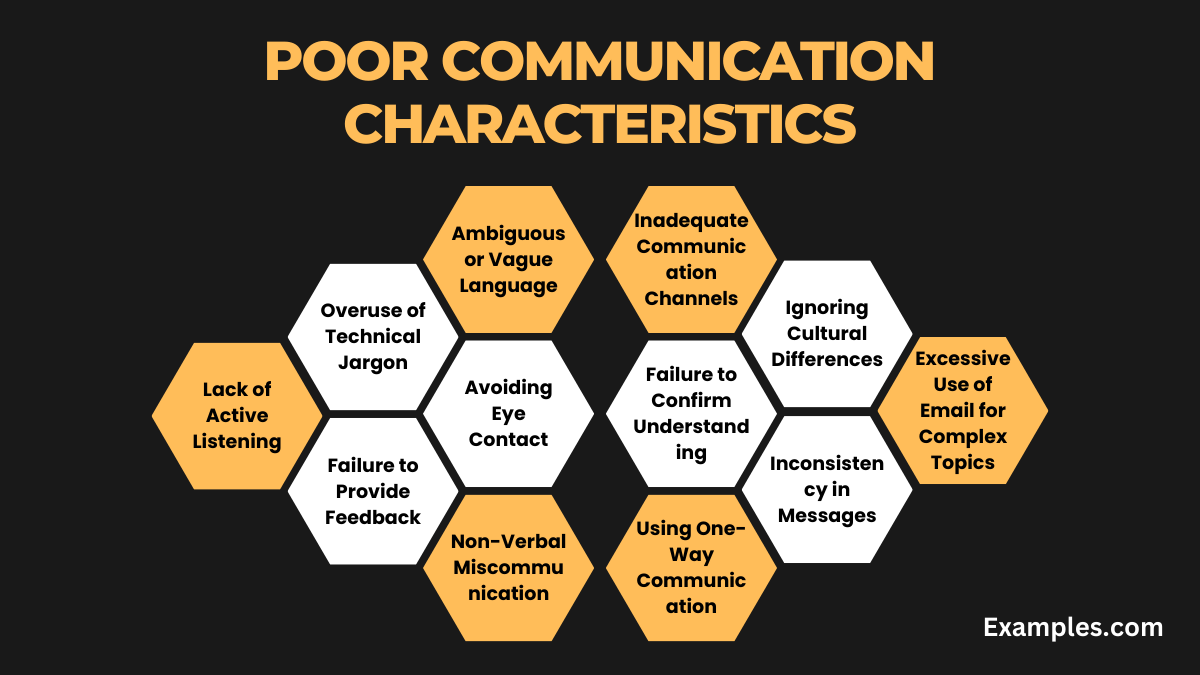14+ Poor Communication Characteristics Examples
Dive into the realm of workplace communication with our guide on Poor Communication Characteristics, enriched with practical communication examples. This guide offers an in-depth look at the various traits that constitute poor communication and their impact on both personal and professional relationships. From non-verbal cues to misaligned messaging, we explore the nuances of communication failures and provide actionable advice on how to overcome these barriers, paving the way for more effective and harmonious interactions.
Download Characteristics of Poor Communication PDF
15 Poor Communication Characteristics

In today’s fast-paced work environment, effective communication is crucial. However, poor communication characteristics can significantly impede team collaboration, project execution, and overall workplace harmony. For those pondering How do you treat lack of communication?, the guide provides practical strategies and solutions. From ambiguous language to lack of feedback, each example is dissected to help understand how these issues arise and what can be done to address them, ensuring smoother and more effective communication in various professional settings.
- Ambiguous or Vague Language: Causes confusion.
Fix: Use clear, specific language and provide detailed instructions. - Overuse of Technical Jargon: Alienates non-expert team members.
Fix: Simplify language and explain technical terms when necessary. - Lack of Active Listening: Leads to misunderstandings.
Fix: Practice active listening by focusing on the speaker and clarifying their points. - Failure to Provide Feedback: Hinders growth and improvement.
Fix: Regularly provide constructive feedback. - Interrupting Others: Disrespects speaker and disrupts flow.
Fix: Cultivate patience and let others finish speaking. - Non-Verbal Miscommunication: Creates misinterpretations.
Fix: Be aware of body language and facial expressions. - Inconsistency in Messages: Causes confusion and mistrust.
Fix: Ensure all communications are aligned and consistent. - Avoiding Difficult Conversations: Leads to unresolved issues.
Fix: Address issues directly but respectfully. - Excessive Use of Email for Complex Topics: Leads to miscommunication.
Fix: Use face-to-face meetings for complex or sensitive discussions. - Ignoring Cultural Differences: Causes misinterpretations.
Fix: Be aware of and respect cultural nuances in communication. - Poor Written Communication Skills: Leads to misinterpretation of emails and documents.
Fix: Improve writing skills and proofread before sending. - Using One-Way Communication: Neglects input from others.
Fix: Encourage two-way communication and feedback. - Failure to Confirm Understanding: Leads to mistakes.
Fix: Summarize and confirm key points after discussions. - Avoiding Eye Contact: Can be perceived as disinterest.
Fix: Maintain appropriate eye contact to show engagement. - Inadequate Communication Channels: Hinders effective information flow.
Fix: Use diverse communication channels suitable for different needs.
By identifying and addressing these characteristics, workplaces can significantly enhance the clarity and effectiveness of their communication, leading to improved teamwork and productivity.From common Lack of Communication Examples to deep-seated Lack of Communication Causes & Reasons, we’ve uncovered how such issues manifest in various relationships, including in marriages and couples.
Poor Communication Characteristics in the Workplace
In the workplace, poor communication can manifest in various forms, each impacting team dynamics and productivity negatively.The exploration of Lack of Communication Skills, particularly the significance of Lack of Eye Contact in Communication, reveals how non-verbal cues play a crucial role.
Recognizing these characteristics is the first step towards improving workplace communication:
- Indirect or Unclear Messages: Leads to misunderstandings and errors.
- Excessive Use of Technical Jargon: Alienates non-expert colleagues.
- Lack of Openness to Feedback: Stifles growth and innovation.
- Non-Verbal Miscommunication: Body language that contradicts verbal messages.
- Inconsistent Information: Creates confusion and mistrust among team members.
- Ignoring or Disregarding Emails: Leads to missed information and delays.
- One-Way Communication: Lacks engagement and feedback from others.
- Over-reliance on Digital Communication: Misses the nuances of face-to-face interactions.
How to Tell Someone They Have Poor Communication
Addressing someone’s poor communication skills delicately and constructively is crucial.We’ve also discussed the broader Lack of Communication Effects, emphasizing the impact in professional settings, such as Lack of Communication in the Workplace and Lack of Communication in Healthcare. :
- Choose the Right Setting: Address the issue in a private and comfortable setting.
- Be Specific and Objective: Provide clear examples of the communication issues.
- Use “I” Statements: Avoid sounding accusatory; focus on how the communication affects you.
- Offer Constructive Feedback: Suggest ways to improve rather than just criticizing.
- Encourage Self-Reflection: Prompt them to consider how their communication style impacts others.
- Be Supportive and Empathetic: Show understanding and willingness to help.
- Follow-Up Conversations: Regular check-ins to discuss progress and ongoing challenges.
- Recommend Resources or Training: Suggest workshops or materials that can help improve their skills.
Symptoms of Poor Communication
Recognizing the symptoms of poor communication can help in addressing the underlying issues Addressing these issues is vital, and this guide has offered insights into How to Fix Lack of Communication and specifically How to Fix Lack of Communication in Relationships:
- Frequent Misunderstandings: Regular confusion over tasks and responsibilities.
- Low Morale: Team members feeling undervalued or ignored.
- High Employee Turnover: Poor communication contributing to job dissatisfaction.
- Increased Conflicts: Misunderstandings leading to conflicts among team members.
- Decreased Productivity: Inefficiencies due to unclear instructions or goals.
- Lack of Innovation: Limited idea sharing due to poor communication channels.
- Customer Complaints: Miscommunications leading to poor customer experiences.
- Resistance to Change: Misinformation or lack of communication regarding changes.
Signs of Poor Communication
Certain signs can indicate the presence of communication issues in a workplace.The article also touched upon the reflective nature of Lack of Communication Quotes & Sayings, including Silence Lack of Communication Quotes and Deep Lack of Communication Quotes, which underscore the emotional depth and complexity of communication challenges:
- Lack of Team Cohesion: Teams not working effectively together.
- Repeated Errors: Mistakes occurring due to miscommunication.
- Unmet Deadlines: Projects delayed due to unclear or missed communications.
- Silence in Meetings: Team members reluctant to share ideas or concerns.
- Email Overload: Excessive reliance on emails for all communications.
- Negative Body Language: Non-verbal cues indicating disengagement or disagreement.
- Lack of Clarity in Roles: Confusion about job responsibilities and expectations.
- Withdrawal from Discussions: Employees not participating actively in conversations.
Cause and Effects of Poor Communication
Understanding the causes and effects of poor communication is vital for finding solutions. For insights into how to achieve this, you can refer to the guide on Effective Communication. This resource provides valuable strategies and tips for enhancing communication skills, which are crucial in addressing the challenges posed by poor communication.:
- Cultural Differences: Leading to misunderstandings and lack of cohesion.
- Generational Gaps: Different communication styles causing disconnects.
- Technological Challenges: Dependence on technology hindering personal interactions.
- Leadership Communication Style: Top-down communication leading to disengagement.
- Stress and Workload: High stress levels impairing effective communication.
- Effects on Employee Well-being: Poor communication contributing to stress and dissatisfaction.
- Impact on Customer Relations: Miscommunication affecting customer service and retention.
- Influence on Company Reputation: External perception affected by internal communication issues.
Addressing these aspects of poor communication is essential for a healthy, efficient, and productive workplace.
In conclusion, this article has explored the various characteristics, effects, and signs of poor communication, along with effective strategies for remediation. By understanding and addressing these aspects, individuals and organizations can significantly improve their communication dynamics, leading to enhanced collaboration, productivity, and overall workplace harmony. Effective communication is key to successful relationships and operations in any professional environment.



